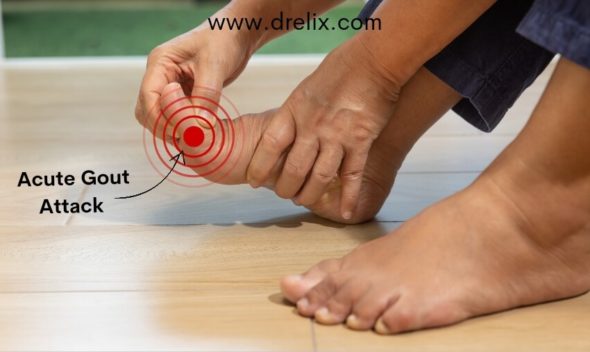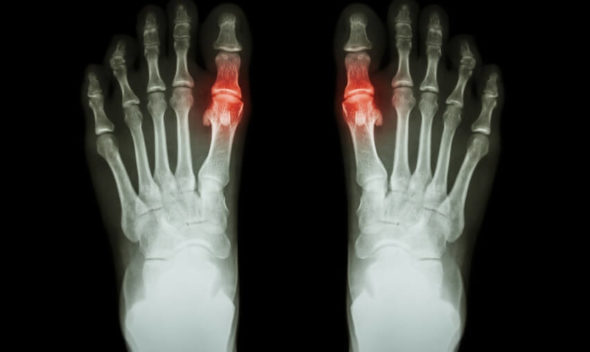
Allopurinol is a medicine that is often advised for the long-term management of gout. A recurrent question that usually gout patients ask is “Why does Allopurinol worsen acute gout?“. But is it true that you are better off without it in acute gout?
This article will look into the effects that allopurinol has in an acute gout attack.
What is Allopurinol?
Allopurinol is a medication that belongs to the class of xanthine oxidase (XO) inhibitors. It works by blocking the production of a substance called uric acid. It can be used in the long-term treatment of gout, an inflammatory disease that causes pain and swelling in the joints.
Allopurinol is also used to treat high uric acid levels in people with kidney stones and in people with certain cancers that are undergoing chemotherapy.
What does Allopurinol do for gout?
Gout results from a high level of uric acid in the blood. Uric acid is normally removed from the body with urine. But if the level of uric acid in the blood increases, it can form urate crystals in the joints. These crystals cause pain, swelling and other signs of gout.
How does Allopurinol work?
Allopurinol stops a substance produced normally by the body, called hypoxanthine from converting to xanthine. It also blocks the next process of xanthine breaking down to uric acid. In this way, it can decrease the level of uric acid in the body.
It is important to understand that allopurinol is first and foremost used for the long-term treatment of gout and prevention of gout attacks. There are other, much more effective methods for the treatment of a gout attack as it is happening.
What happens if you take Allopurinol during a gout attack?
Acute gout presents with gout attacks or flares – episodes of gout marked by peak uric acid levels, high inflammation and excruciating pain.
According to a source, allopurinol can worsen your gout attack if you start using it for the first time during the attack. This source suggests that you should wait for at least two weeks after the acute attack ends to start allopurinol therapy.
The same source also argues that by lowering the level of uric acid, allopurinol may cause the release of urate crystals from the joint cartilage into the joint space. This results in acute, high inflammation, which then gives rise to gout pain and other signs of gout.
Patient trials have shown that allopurinol might also dissolve urate crystals, raising uric acid level to dangerous extreme levels. It may even damage cartilage and nerve endings, causing a burning sensation and adding to gout pain.
Other studies have shown that allopurinol, even when started during an acute gout attack, causes no meaningful difference in acute pain, repeated attacks, or inflammation level.
So, with the different results in studies, what is the right thing for you to do?
We may conclude that if you are already using allopurinol, you should not stop it when a gout attack starts. During a gout attack, you can lower the dosage of allopurinol and combine it with fast pain-relieving treatment methods.
Pain-relieving methods for gout include topical therapies that get rid of gout pain fast, such as Dr. Elix’s Gout Pain Relief, or various painkillers, such as NSAIDs, colchicine or corticosteroids.
If you have not used allopurinol before, you can start using it during an attack, but only titrated in low-doses. Starting allopurinol treatment in high-doses from the get-go will most likely precipitate an acute gout attack.
What is the best way to take Allopurinol?
Allopurinol usually comes in tablet form and can be used only as advised and prescribed by your doctor.
Allopurinol therapy should be started at a dose of 50-100 mg per day. In patients with previous kidney disease, the dose should be less than 50 mg per day. After a gout attack ends, it is advised to gradually increase the dose of allopurinol to achieve better long-term treatment results.
You may take a dose with food to prevent feeling unwell. It is recommended to drink a lot of water (2 liters a day) when using allopurinol therapy to prevent the risk of kidney stones.
How quickly does Allopurinol lower uric acid?
With allopurinol treatment, uric acid levels can be lowered within one to three weeks. Effectively reducing gout attacks may take a little more time – around two to six weeks, or even a few months.
You should know that it is completely possible to experience a gout attack in the first weeks even after starting treatment with allopurinol.
What are the side effects of Allopurinol?
Before starting allopurinol therapy, your doctor will ask you a few questions about your medical history and conduct a few tests. You may need to reconsider treatment with allopurinol if:
- You have a certain gene marker, known as HLA-B*5801
- You have an allergic reaction to allopurinol or any medicine of the same class
- You are pregnant or breastfeeding
- You have a kidney or liver disease
- You have a thyroid disease
- You are using certain medicines that react with allopurinol.
Allopurinol can cause a few unwanted side effects, which include:
- A skin rash, as a sign of an allergy to allopurinol
- Changes to thyroid stimulating hormone (TSH) levels
- Pain when urinating or blood in urine
- Fever, chills, sore throat (flu symptoms)
- Nausea
- Diarrhea
- Drowsiness
- Weight loss
- Loss of appetite
- Rarely, liver damage or elevations in liver enzymes
- Rarely, bone marrow suppression
- Kidney damage (in patients with previous kidney disease)
Seek medical care immediately if you notice that you have developed any of these side effects.
Treatment options for gout attack
If you experience a gout attack, you have various effective treatment options which relieve the pain and other gout signs quickly. These treatments may be used long-term as well as in combination or without allopurinol therapy.
Dr. Elix’s gout pain relief topical treatment
One of the best methods to get rid of gout pain quickly during a gout attack is applying Dr.Elix gout pain relief directly to your joints. This topical treatment comes in the form of a lotion that has powerful and effective therapeutic effects, which relieve gout pain in joints in a matter of minutes. These effects include:
- Anti-inflammatory effects
- Antibacterial effects
- Antiseptic effects
- Crystal-breaking and removing effects.
It also heals injured tissues and ligaments and repairs damaged cartilage, making it a great solution for long-term use as well.
Another method is using painkillers, either over-the-counter (NSAIDs) or prescribed (corticosteroids and colchicine).
Home remedies for gout
You can also manage a gout attack by using the following selected gout home remedies such as:
- Applying ice packs to your joint
- Soaking your joint into cold water
- Resting and elevating your joint
- Staying hydrated
- Using painkiller medicine
Drinking plenty of water helps your kidneys remove excess fluids and flush out uric acid. Water keeps you hydrated, energetic, focused and is a great replacement for sugary drinks and alcohol. The recommended daily amount of water that you should drink during a gout attack is 16 glasses.
If you are going through a gout attack, you should put special importance on what you eat and drink. Be careful to avoid sweetened drinks, alcoholic drinks and purine-rich foods.
Some drinks and foods that ease signs of gout during an attack and that should be part of any gout diet are:
- Cherries and tart cherry juice. Have anthocyanins, substances with excellent antioxidant and anti-inflammatory properties.
- Skimmed or low-fat milk. Helps decrease uric acid levels by removing excess uric acid with urine.
- Squeezed lemon mixed with water. Neutralizes uric acid in the body, by stimulating the release of calcium carbonate from the pancreas.
- Herbal teas (nettle, dandelion, hibiscus). Decrease the production of inflammatory substances and help the kidney remove excess uric acid.
- Ginger root. Fights inflammation and reduces pain and swelling.
- Celery seeds. Contain luteolin, a urate-reducing substance.
- Apples and bananas. Reduce uric acids and are rich in water. They also contain sugar, which is why you should only consume one of each daily.
- Onions. Contain flavonoids, substances which reduce uric acid production.
- Cucumbers. Are almost entirely made up of water. In this way they flush out uric acid from the body.
- Potatoes. Are a great option to add to your diet as they contain almost no purines.
Takeaway
Allopurinol is a medication that belongs to the class of xanthine oxidase (XO) inhibitors. It works by blocking the production of a substance called uric acid.
During a gout attack, you should lower the dosage of allopurinol and combine it with fast painrelieving treatment methods. If you have not used allopurinol before, you can start using it during an attack, but only in low-doses. Starting high-dose allopurinol treatment immediately will most likely precipitate an acute gout attack.
Allopurinol is primarily used for the long-term treatment of gout and prevention of gout attacks.
There are other much more effective methods for the treatment of acute gout.
Dr.Elix’s gout pain relief topical treatment is a highly effective method which relieves gout pain during a gout attack within minutes. Other recommended treatment options to get rid of gout signs during a gout attack are home remedies, lifestyle and diet changes.













Leave a comment